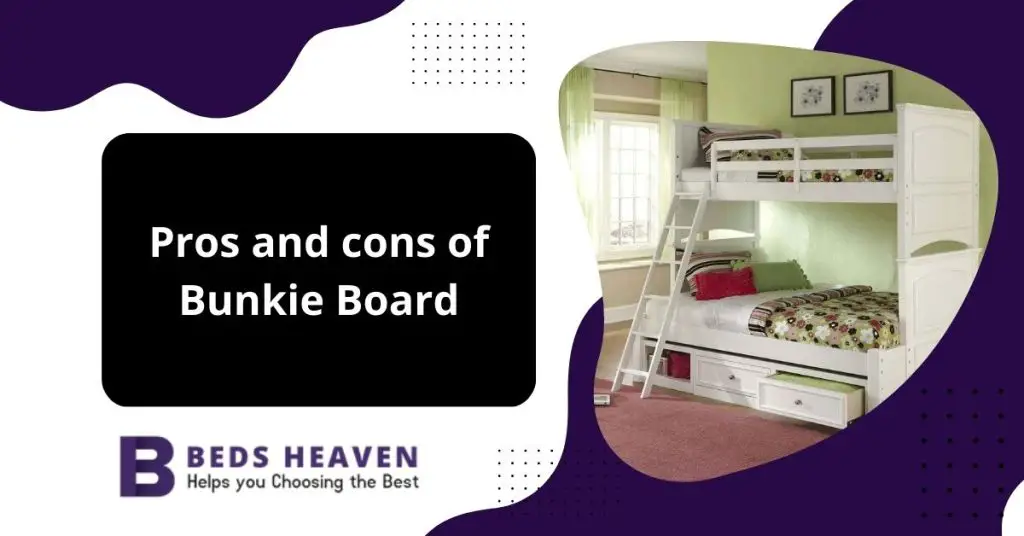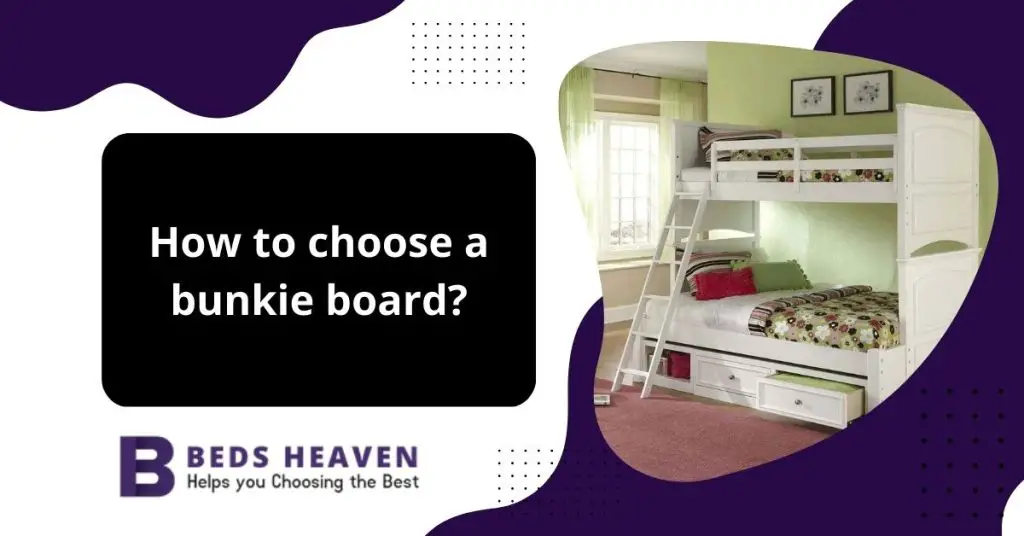Last updated on February 2nd, 2023 at 12:59 pm
Here you will find a detailed guide on How to make a bunkie board for a bunk bed? This also includes Tips and Warnings for the creators.
Introduction
Quick Links
Bunkie boards are relatively easy to make if you know how to use a circular saw. If not, ask the lumberyard to cut the boards for you.
Slat-style beds without box springs, such as bunk beds and platform beds, can be downright uncomfortable, especially when they’re paired with thin or insubstantial mattresses. Bunkie boards solve this problem.
Fabric-wrapped plywood provides just a little height and, more importantly, a flat surface to eliminate the bumpy feeling caused by the slats. Additionally, the board reduces the amount of friction or rubbing that otherwise occurs between it and exposed slats.
How to make a bunkie board for a bunk bed?

How to make a bunkie board for a bunk bed? To provide additional support and comfort for a mattress, bunkie boards are thin, flat foundations that are placed on top of the bunk bed slats.
Keeping the mattress in good condition and ensuring a good night’s sleep is essential to its longevity. Making your own bunkie board is a cost-effective and customizable option if you wish to upgrade your bunk bed. This guide will guide you through the process of creating a bunkie board.
1. Measure the Frame
The mattress should be removed. Take a measurement of the area occupied by the mattress on the side and end rails of the bed frame. Remove 2 inches from both the width and length — that is, one inch from each side.
Adjust the bunkie board size accordingly — the shortened size allows for the wraparound padded fabric, which softens the board’s edges and surface, making it less likely to puncture or damage the mattress. The smaller the board, the thicker the padding.
2. Cut the Plywood
Using a circular saw and carbide blade designed for plywood, cut the 3/4-inch plywood to the desired size. If your twin-sized bed or twin bunk-bed frames measure 38 by 75 inches, for example, you might wish to cut the board to 36.5 by 73.5 inches, allowing an inch and a half on each span for upholstery-quality quilted fabric.
3. Sand It Smooth
Use medium-grit sandpaper to abrade the edges and rough spots on both sides of the board. With a power sander, sanding plywood is relatively quick and easy. Over time, wood that is at least somewhat smooth is less likely to cause wear and tear.
4. Cut the Quilted Upholstery Fabric
Layout the quilted upholstery on the floor or another large work surface, wrong side up if applicable. Use scissors to cut two pieces — one for the top and one for the bottom of the bunkie board.
Although the bottom piece can measure the board’s exact width and length, the top piece should be a few inches longer and overlap the fabric on the bottom for stapling.
A full-sized bunkie board should, for example, have a bottom fabric that measures 53 inches by 74 inches. size, and the top piece to about 59 by 80 inches, leaving a few inches on each side for stretching around.
5. Apply the Glue
Apply fabric adhesive to the plywood’s upward-facing side. Smooth the exact-fitting bottom upholstery or dustcover over the board, centered lengthwise and widthwise. Turn the plywood over. Apply adhesive to the plywood’s upper side. Put the slightly oversized piece of fabric into place, centering it as with the other side, and fold and staple each corner.
6. Finish With Staples
For a more padded finish, fold and staple the excess quilting onto the board rather than trimming it.
Tips
- The lumberyard where you intend to buy the plywood can often cut lumber to size for you if you don’t feel comfortable using a circular saw, so be prepared with the measurements.
- Using quilted fabric just on the top side of the bunkie board and inexpensive dust-cover material on the bottom will save you money.
- When you work with a king-size bunkie board, it’s easier to have someone help you apply the fabric than to do it alone.
Warning
Open windows for ventilation when using any adhesive, and read the label for any other precautions.
Pros and cons of Bunkie Board

A bunkie board is a thin, flat foundation that sits on top of a bunk bed’s slats to provide extra support and comfort for a mattress. While bunkie boards can be a great solution for improving the overall sleep experience on a bunk bed, it’s important to understand the pros and cons before making a decision.
Pros:
1. Support:
Bunkie boards provide an extra layer of support for the mattress, which can help to prolong its lifespan and improve sleep comfort.
2. Low profile:
Bunkie boards are thin and low-profile, making them a great option for bunk beds with limited space.
3. Customizable:
Bunkie boards can be customized to fit the specific dimensions of a bunk bed and can be made with a variety of materials to suit personal preferences.
4. Cost-effective:
Making your own bunkie board is a cost-effective option as compared to buying a new mattress.
Cons:
1. Not suitable for all mattresses:
Some mattresses may not be compatible with a bunkie board and may require a traditional box spring for proper support.
2. Regular maintenance:
Bunkie boards require regular maintenance such as checking the tightness of the screws, and the condition of the fabric or foam to ensure they last for a long time.
Final Words:
A bunkie board can be a great option for those looking to improve the support and comfort of their bunk bed, but it’s important to weigh the pros and cons before making a decision. It’s always a good idea to consult with a mattress expert or do proper research before making any decision.
How to choose a bunkie board?
In bunk beds, a bunkie board is an important component that can greatly improve the overall sleeping experience. A bunkie board consists of a thin, flat foundation that is placed on top of the bunk bed’s slats to provide additional support and comfort.

It can be challenging to make a decision about which bunkie board is best for you, but with the right information, you can make an informed decision. Here are a few key factors to keep in mind when choosing a bunkie board:
1. Size:
The first and foremost important factor to consider is the size of the bunkie board. Make sure to measure the length and width of your bunk bed’s slats to ensure that you choose the correct size bunkie board.
2. Material:
Bunkie boards are typically made from plywood or particle board. Plywood is more durable and provides more support, while particle board is cheaper but less durable. Consider your budget and the level of support you need when choosing a material.
3. Comfort:
A bunkie board provides not only support but also comfort. Consider whether you want a cushioned surface or a firmer surface. Some bunkie boards come with a foam layer on top to provide extra comfort.
4. Installation:
Some bunkie boards come pre-assembled, while others require assembly. Consider the level of difficulty and your own skills before choosing a bunkie board.
5. Personalization:
You can also choose a bunkie board that can be personalized to your style. Some bunkie boards come with removable fabric covers that can be washed or changed out to match your room’s decor.
6. Durability:
Consider the durability of the bunkie board. Make sure to choose a bunkie board made from high-quality materials that can withstand regular use.
Final Words:
Choosing the right bunkie board is important for the overall sleep experience on a bunk bed. Consider the size, material, comfort, installation, personalization, and durability when making your decision. It’s always best to consult with a mattress expert or do proper research before making a decision.
FAQ’s
1. What is a bunkie board?
Bunkie boards are thin platforms made of wood or metal that support the bunk bed mattress and prevent it from sagging.
2. Is a bunkie board necessary for a bunk bed?
There is no need for a bunk board for a bunk bed, but a bunkie board is recommended to give the mattress added support and prevent it from sagging, which can cause discomfort and shorten the mattress’ lifespan.
3. Can I use a box spring instead of a bunkie board?
Alternatively to a bunkie board, a box spring can be used, however, it is generally thicker and may not fit comfortably in a bunk bed. A bunkie board is specifically designed to fit bunk beds, so it is recommended to use one.
4. How do I choose the right size bunkie board for my bunk bed?
It is important to measure the interior dimensions of the bed frame in order to determine what size bunkie board you need for your bunk bed. The bunkie board should fit snugly inside the bed frame.
Conclusion
When choosing a bunk bed, be sure to choose the right size to fit your bed frame and to ensure maximum comfort and support. Bunkie boards are not a requirement for a bunk bed, but they are highly recommended for added support and to extend the life of your mattress.
